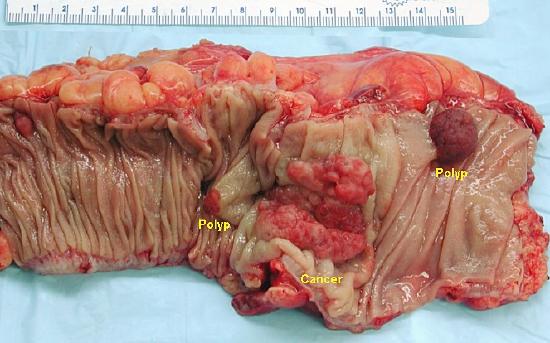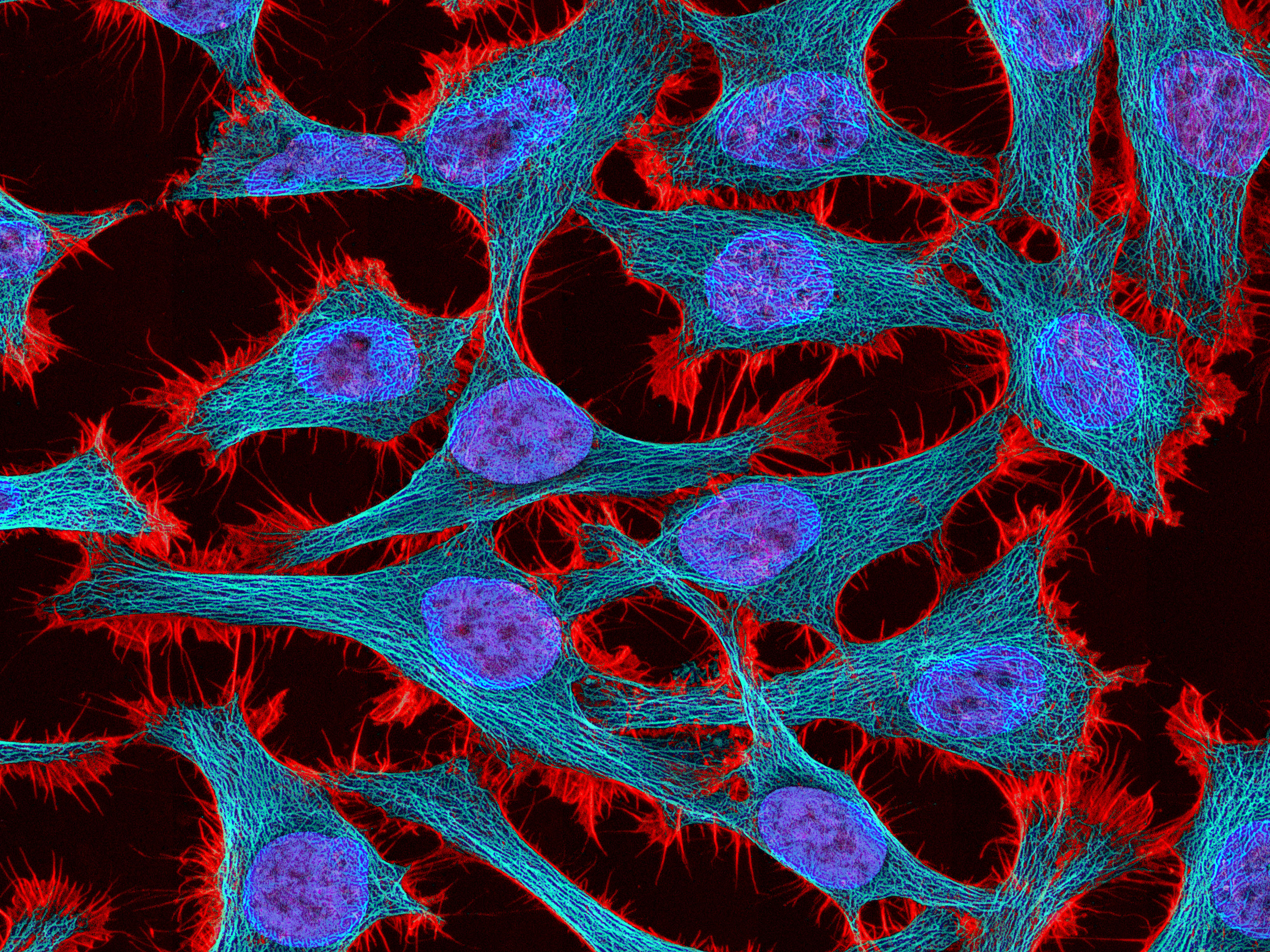A Family of Proteins That Regulate the Cell Cycle in Eukaryotic Cells
7.two: Cell Bike and Cell Sectionalisation
- Page ID
- 16754
The baby in Effigy \(\PageIndex{1}\) has a lot of growing to do before they are every bit big as their mom. Most of their growth will be the result of prison cell division. By the fourth dimension the babe is an adult, their trunk will consist of trillions of cells. Prison cell division is but ane of the stages that all cells go through during their life. This includes cells that are harmful, such as cancer cells. Cancer cells separate more often than normal cells and grow out of control. In fact, this is how cancer cells cause illness. In this concept, you lot volition read about how cells separate, what other stages cells become through, and what causes cancer cells to separate out of control and harm the trunk.

The Cell Cycle
Cell division is the process in which one cell, chosen the parent jail cell, divides to grade ii new cells, referred to as daughter cells. How this happens depends on whether the prison cell is prokaryotic or eukaryotic. Cell division is simpler in prokaryotes than eukaryotes because prokaryotic cells themselves are simpler. Prokaryotic cells have a unmarried round chromosome, no nucleus, and few other organelles. Eukaryotic cells, in contrast, have multiple chromosomes contained within a nucleus and many other organelles. All of these prison cell parts must be duplicated and then separated when the jail cell divides. Prison cell division is just i of several stages that a jail cell goes through during its lifetime. The cell cycle is a repeating series of events that include growth, Deoxyribonucleic acid synthesis, and prison cell division. The cell cycle in prokaryotes is quite simple: the cell grows, its DNA replicates, and the cell divides. This class of division in prokaryotes is called asexual reproduction. In eukaryotes, the jail cell wheel is more complicated.
Eukaryotic Cell Cycle
Figure \(\PageIndex{ii}\) represents the cell cycle of a eukaryotic cell. Equally y'all can run across, the eukaryotic cell cycle has several phases. The mitotic stage (G) includes both mitosis and cytokinesis. This is when the nucleus and then the cytoplasm divide. The other 3 phases (Gone, S, and G2) are generally grouped together every bit interphase. During interphase, the cell grows, performs routine life processes, and prepares to dissever. These phases are discussed below.
Interphase
The Interphase of the eukaryotic cell cycle tin be subdivided into the following phases (Figure \(\PageIndex{2}\)).
- Growth Phase 1 (G1): The prison cell spends nearly of its life in the first gap (sometimes referred to as growth) stage, Gane. During this phase, a cell undergoes rapid growth and performs its routine functions. During this phase, the biosynthetic and metabolic activities of the prison cell occur at a high rate. The synthesis of amino acids and hundreds of thousands or millions of proteins that are required by the cell occurs during this phase. Proteins produced include those needed for Deoxyribonucleic acid replication. If a prison cell is non dividing, the prison cell enters the G0 stage from this phase.
- G0 stage: The Yard0 stage is a resting phase where the prison cell has left the bicycle and has stopped dividing. Non-dividing cells in multicellular eukaryotic organisms enter G0 from Gone. These cells may remain in Chiliad0 for long periods of time, even indefinitely, such as with neurons. Cells that are completely differentiated may also enter Yard0. Some cells stop dividing when problems of sustainability or viability of their daughter cells arise, such as with Deoxyribonucleic acid damage or degradation, a procedure called cellular senescence. Cellular senescence occurs when normal diploid cells lose the power to divide, normally later about 50 cell divisions.
- Synthesis Stage (Southward): Dividing cells enter the Synthesis (S) stage from Gi. For two genetically identical daughter cells to be formed, the cell's DNA must exist copied through Deoxyribonucleic acid replication. When the Deoxyribonucleic acid is replicated, both strands of the double helix are used every bit templates to produce two new complementary strands. These new strands and then hydrogen bond to the template strands and two double helices form. During this stage, the corporeality of Dna in the cell has finer doubled, though the cell remains in a diploid state.
- Growth Stage ii (Thousand2): The second gap (growth) (Gtwo) phase is a shortened growth period in which many organelles are reproduced or manufactured. Parts necessary for mitosis and prison cell division are fabricated during K2, including microtubules used in the mitotic spindle.
Mitotic Phase
Before a eukaryotic jail cell divides, all the DNA in the cell's multiple chromosomes is replicated. Its organelles are also duplicated. This happens in the interphase. Then, when the cell divides (mitotic phase), it occurs in two major steps, called mitosis and cytokinesis, both of which are described in greater item in the concept Mitotic Phase: Mitosis and Cytokinesis.
- The get-go step in the mitotic stage of a eukaryotic cell is mitosis, a multi-phase process in which the nucleus of the cell divides. During mitosis, the nuclear envelope (membrane) breaks downward and afterwards reforms. The chromosomes are also sorted and separated to ensure that each daughter cell receives a consummate set of chromosomes.
- The second major stride is cytokinesis. This pace, which occurs in prokaryotic cells as well, is when the cytoplasm divides and two girl cells form.
| State | Name | Clarification |
|---|---|---|
| Quiescent Senescent | Resting stage (One thousand0) | A resting phase where the cell has left the wheel and has stopped dividing. |
| Interphase | 1st growth phase (Thouone) Synthesis stage (Due south) 2ndgrowth stage (Gtwo) | Cells increase in size in Yard1. Cells perform their normal activities. Dna replication occurs during this phase. The cell will keep to grow and many organelles will divide during their phase. |
| Cell division | Mitosis (M) | Jail cell growth stops at this phase. Mitosis divides the nucleus into two nuclei, followed past cytokinesis which divides the cytoplasm. Two genetically identical girl cells result. |
Command of the Cell Bike
If the cell cycle occurred without regulation, cells might go from one phase to the side by side before they were ready. What controls the prison cell cycle? How does the jail cell know when to grow, synthesize DNA, and divide? The cell bicycle is controlled mainly by regulatory proteins. These proteins command the bicycle by signaling the cell to either start or filibuster the next phase of the cycle. They ensure that the cell completes the previous phase before moving on. Regulatory proteins control the cell bike at key checkpoints, which are shown in Figure \(\PageIndex{iii}\). In that location are a number of main checkpoints:
- The G1 checkpoint: just before entry into the S phase, makes the key decision of whether the cell big enough to divide. If the jail cell is non large plenty, information technology goes into the resting menstruum (Chiliad0)
- DNA synthesis Checkpoint: The S checkpoint determines if the Deoxyribonucleic acid has been replicated properly.
- The mitosis checkpoint: This checkpoint ensures that all the chromosomes are properly aligned before the cell is immune to split.

Cancer and the Cell Cycle
Cancer is a affliction that occurs when the cell wheel is no longer regulated. This happens because a prison cell'southward DNA becomes damaged. This results in mutations in the genes that regulate the cell cycle. Damage tin can occur due to exposure to hazards such as radiations or toxic chemicals. Cancerous cells mostly split much faster than normal cells. They may form a mass of abnormal cells chosen a tumor (see Figure \(\PageIndex{4}\)). The rapidly dividing cells take up nutrients and space that normal cells need. This tin can impairment tissues and organs and eventually atomic number 82 to death. When uncontrolled cell division happens in the bone marrow, abnormal and nonfunctional blood cells are produced because the division is happening before the cell is ready for division. In these types of cancer, at that place is not any evident tumor.

Henrietta Lacks sought treatment for her cancer at Johns Hopkins University Hospital at a time when researchers were trying to abound human cells in the lab for medical testing. Despite many attempts, the cells always died earlier they had undergone many jail cell divisions. Mrs. Lacks's md took a small sample of cells from her tumor without her knowledge and gave them to a Johns Hopkins researcher, who tried to grow them on a culture plate. For the first time in history, homo cells grown on a culture plate kept dividing...and dividing and dividing and dividing. Copies of Henrietta'due south Lacks cells — called HeLa cells for her name — are still live today. In fact, there are currently many billions of HeLa cells in laboratories effectually the earth!

Why Henrietta Lacks' cells lived on when other human cells did not is still something of a mystery, but they are clearly extremely hardy and resilient cells. By 1953, when researchers learned of their power to keep dividing indefinitely, factories were set up to first producing the cells commercially on a large scale for medical research. Since then, HeLa cells have been used in thousands of studies and have made possible hundreds of medical advances. For example, Jonas Salk used the cells in the early on 1950s to test his polio vaccine. Over the decades since then, HeLa cells have been used to make of import discoveries in the study of cancer, AIDS, and many other diseases. The cells were even sent to infinite on early infinite missions to learn how human cells respond to zero gravity. HeLa cells were likewise the first homo cells e'er cloned, and their genes were some of the start e'er mapped. It is well-nigh impossible to overestimate the profound importance of HeLa cells to homo biology and medicine.
Yous would recollect that Henrietta Lacks' proper noun would exist well known in medical history for her unparalleled contributions to biomedical research. However, until 2010, her story was virtually unknown. That year, a science author named Rebecca Skloot published a nonfiction book about Henrietta Lacks, named The Immortal Life of Henrietta Lacks. Based on a decade of research, the book is riveting, and information technology became an nigh instantaneous best seller. Equally of 2016, Oprah Winfrey and collaborators planned to make a movie based on the volume, and in contempo years, numerous articles about Henrietta Lacks have appeared in the press.
Ironically, Henrietta herself never knew her cells had been taken, and neither did her family. While her cells were making a lot of money and edifice scientific careers, her children were living in poverty, besides poor to afford medical insurance. The story of Henrietta Lacks and her immortal cells raises ethical issues about human tissues and who controls them in biomedical enquiry. However, at that place is no question that Henrietta Lacks deserves far more recognition for her contribution to the advancement of scientific discipline and medicine.
Review
- What are the two primary phases of the jail cell cycle in a eukaryotic prison cell?
- Describe the three phases of interphase in a eukaryotic cell.
- Explain how the prison cell cycle is controlled.
- How is cancer-related to the prison cell wheel?
- What are the two major steps of cell sectionalisation in a eukaryotic cell?
- In which phase of the eukaryotic cell cycle exercise cells typically spend most of their lives?
- Which phases of the cell cycle will have cells with twice the amount of Dna? Explain your answer.
- If there is damage to a gene that encodes for a cell cycle regulatory protein, what do you think might happen? Explain your answer.
- True or False . Cells go into Thou0 if they do not pass the G1 checkpoint.
- In which stage within interphase does the prison cell make final preparations to carve up?
- Mitosis
- Cytokinesis
- G2
- Due south
- What were scientists trying to do when they took tumor cells from Henrietta Lacks? Why did they specifically use tumor cells to endeavor to achieve their goal?
Explore More than
Source: https://bio.libretexts.org/Bookshelves/Human_Biology/Book%3A_Human_Biology_(Wakim_and_Grewal)/07%3A_Cell_Reproduction/7.2%3A_Cell_Cycle_and_Cell_Division

Post a Comment for "A Family of Proteins That Regulate the Cell Cycle in Eukaryotic Cells"